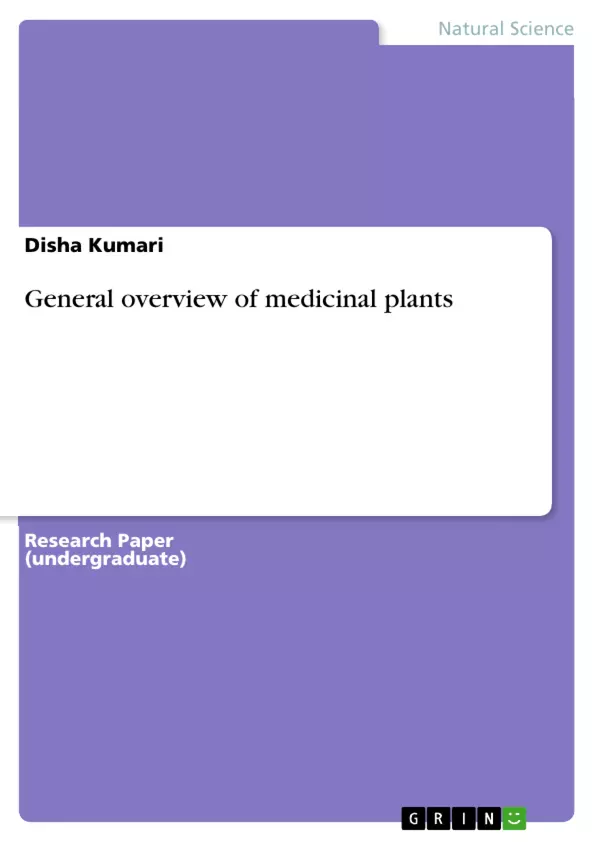Medicinal plants have been discovered and used in traditional medicine practices since prehistoric times also hundreds of chemical compounds for functions including defence against insects, fungi, diseases, and herbivorous mammals were known since then. Somany medicinal plants are resources of new drugs and many of the modern medicines are produced indirectly from the plants. The medicinal plants helps to protect human and animals from natural poisons. The importance of traditional medicine has also recognized by WHO.
Table of Contents
- Introduction
- Literature Review
- List of Plant Species
- Conclusion
Objectives and Key Themes
This text aims to provide a general overview of medicinal plants, focusing on their historical use, chemical composition, and pharmacological properties. It explores the potential of these plants as sources of therapeutic agents and alternatives to synthetic compounds.
- The historical and traditional uses of medicinal plants.
- The chemical composition of medicinal plants and their bioactive components.
- The pharmacological activities of medicinal plants and their applications in treating various diseases.
- The comparison of natural and synthetic antioxidants.
- The role of ethnobotany in drug discovery.
Chapter Summaries
Introduction: This introductory chapter establishes the importance of medicinal plants as a global resource, highlighting their significant antioxidant potential and use in treating various diseases. It underscores the historical significance of these plants in traditional medicine and their role as a potential source of side-effect-free alternatives to synthetic antioxidants in the food processing industry and preventive medicine. The chapter introduces the diverse phytochemicals found in plants and their roles in defense mechanisms, emphasizing the complexity of their effects and the need for comprehensive understanding in medicinal applications. The role of ethnobotany in the discovery of pharmacologically active substances is also highlighted.
Literature Review: This chapter reviews several studies on specific medicinal plants. It examines Terminalia chebula, detailing its chemical constituents and various biological activities, including antioxidant, anti-diabetic, and anti-inflammatory properties. The review also covers Triphala, a herbal drug combination, emphasizing its polyphenolic components and diverse pharmacological activities such as anti-inflammatory, anti-cancer, and antioxidant effects. Further, it touches upon Ayurveda's significance, highlighting its growing global recognition and the numerous herbal plants used for medicinal purposes worldwide, with a special focus on Triphala's health benefits. Finally, the chapter includes a discussion of Terminalia arjuna, detailing its traditional uses in various Indian medical systems and its rich phytochemical composition, emphasizing its numerous pharmacological activities, from antimicrobial to wound healing properties. The chapter concludes with a broader perspective on medicinal plants as a historical source of therapeutic agents, emphasizing the importance of further research into their potential.
Keywords
Medicinal plants, phytochemicals, antioxidants, traditional medicine, Ayurveda, Terminalia chebula, Triphala, Terminalia arjuna, pharmacological activities, ethnobotany, drug discovery, bioactive components.
Frequently Asked Questions: A Comprehensive Language Preview of Medicinal Plants
What is the purpose of this text?
This text provides a general overview of medicinal plants, focusing on their historical use, chemical composition, pharmacological properties, and potential as therapeutic agents and alternatives to synthetic compounds. It explores the historical and traditional uses, chemical composition and bioactive components, pharmacological activities and applications in treating diseases, and the role of ethnobotany in drug discovery. A key focus is the comparison of natural and synthetic antioxidants.
What topics are covered in the text?
The text covers the following key themes: the historical and traditional uses of medicinal plants; the chemical composition of medicinal plants and their bioactive components; the pharmacological activities of medicinal plants and their applications in treating various diseases; a comparison of natural and synthetic antioxidants; and the role of ethnobotany in drug discovery. Specific plants discussed include Terminalia chebula, Triphala, and Terminalia arjuna.
What is included in the Table of Contents?
The Table of Contents includes an Introduction, Literature Review, a List of Plant Species, and a Conclusion.
What are the chapter summaries?
The Introduction establishes the importance of medicinal plants, highlighting their antioxidant potential and use in treating diseases, their historical significance, and the role of ethnobotany in drug discovery. The Literature Review examines studies on specific medicinal plants like Terminalia chebula, Triphala, and Terminalia arjuna, detailing their chemical constituents, biological activities, and traditional uses. It emphasizes the growing global recognition of Ayurveda and the numerous herbal plants used for medicinal purposes.
What are the key plants discussed in the Literature Review?
The Literature Review focuses on Terminalia chebula (detailing its chemical constituents and biological activities, including antioxidant, anti-diabetic, and anti-inflammatory properties), Triphala (a herbal drug combination, emphasizing its polyphenolic components and diverse pharmacological activities), and Terminalia arjuna (detailing its traditional uses and pharmacological activities).
What are the keywords associated with this text?
Keywords include: Medicinal plants, phytochemicals, antioxidants, traditional medicine, Ayurveda, Terminalia chebula, Triphala, Terminalia arjuna, pharmacological activities, ethnobotany, drug discovery, bioactive components.
What is the overall scope of the text?
The text offers a comprehensive preview, providing an overview of the key concepts and findings related to medicinal plants, their uses, chemical compositions, and pharmacological activities. It aims to be a structured and professional resource for academic use, focusing on the analysis of themes related to medicinal plants and their applications.
- Quote paper
- Disha Kumari (Author), 2019, General overview of medicinal plants, Munich, GRIN Verlag, https://www.hausarbeiten.de/document/468970


